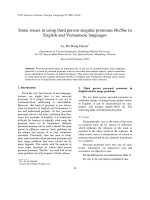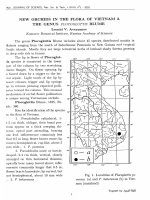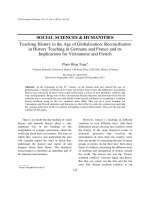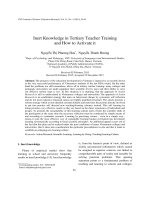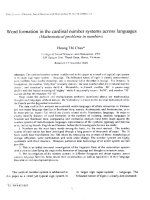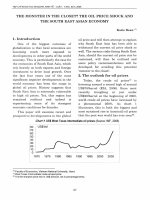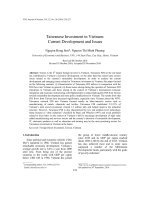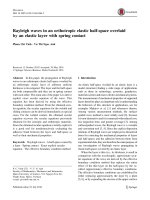DSpace at VNU: Outage analysis in cooperative cognitive networks with opportunistic relay selection under imperfect channel information
Bạn đang xem bản rút gọn của tài liệu. Xem và tải ngay bản đầy đủ của tài liệu tại đây (951.21 KB, 9 trang )
Int. J. Electron. Commun. (AEÜ) 69 (2015) 1700–1708
Contents lists available at ScienceDirect
International Journal of Electronics and
Communications (AEÜ)
journal homepage: www.elsevier.com/locate/aeue
Outage analysis in cooperative cognitive networks with opportunistic
relay selection under imperfect channel information
Khuong Ho-Van ∗
Telecommunications Engineering Department, Ho Chi Minh City University of Technology, 268 Ly Thuong Kiet Str., District 10, Ho Chi Minh City, Viet Nam
a r t i c l e
i n f o
Article history:
Received 8 February 2015
Accepted 7 August 2015
Keywords:
Opportunistic relay selection
Imperfect channel information
Cognitive radio
Performance saturation
a b s t r a c t
This paper proposes exact and limit outage probability expressions for thoroughly evaluating the
performance of cooperative cognitive networks with opportunistic relay selection under imperfect channel information, independent and non-identical (i.n.i.) Rayleigh fading channels, maximum transmit
power constraint, and interference power constraint. The proposed derivations can be straightforwardly
extended to corresponding analysis in dual-hop cognitive networks with opportunistic relay selection
to investigate how much performance gain can be achieved from using the direct channel between the
source and the destination in relaying communications. Numerous results illustrate significant outage
performance degradation and performance saturation due to channel information imperfection but the
degradation and saturation level can be remedied by increasing the number of relays. Also, the channel direct brings a considerable performance improvement without any additional expense of system
resources such as power and bandwidth. Moreover, channel information imperfection can cause interference power at primary users to exceed a pre-defined level, deteriorating the quality of service of
primary users.
© 2015 Elsevier GmbH. All rights reserved.
1. Introduction
Traditional static spectrum allocation is not flexible and
induces low spectrum utilization efficiency [1]. This issue turned
with high radio spectrum demand of emerging wireless services
requires appropriate solutions to mitigate current spectrum
under-utilization. Cognitive radio technology, which allows secondary/unlicensed users (SUs) to opportunistically access the
spectrum inherently allotted to primary/licensed users (PUs), is
a right solution to these critical issues [2]. Nevertheless, in order
to assure transparent communication of PUs, SUs must limit their
transmit power for acceptable interference at PUs, and thus, reducing the communication coverage of secondary transmitters. With
the advantage of wide radio coverage, relaying techniques have
recently been incorporated into SUs to complement the drawback
of the short radio range of SUs [3]. The relaying process can be
assisted by multiple relays for high performance but low bandwidth efficiency due to the requirement of orthogonal channels for
different relays in order to prevent mutual interference. As such,
selecting a single relay among all possible candidates according
∗ Corresponding author. Tel.: +84 1229900719.
E-mail address:
/>1434-8411/© 2015 Elsevier GmbH. All rights reserved.
to a certain criterion is preferred to optimize system resource
utilization (e.g., power and bandwidth), in comparison with multirelay assisted transmission while remaining the same diversity
order [4]. Furthermore, channel state information is very important in the process of system design optimization (e.g., optimal
signal detection). However, it is inevitable that this information
cannot be collected without any error. Therefore, the impact of
imperfect channel information (ICI) on the outage performance of
relay selection criteria in cognitive relaying networks should be
thoroughly investigated before practical implementation.
The impact of ICI1 on the opportunistic relay selection in
dual-hop cognitive networks (i.e., without considering the direct
channel), which selects the relay with the maximum end-to-end
1
The impact of ICI on cognitive radio networks was studied in different aspects;
for example, dual-hop relaying with relay selection (e.g., [7,6,5]), direct transmission (i.e., no relay) [8], the amplify-and-forward relay selection (e.g., [10,9]),
relay non-selection (e.g., [11,13,15,12,14]). Moreover, several relay selection criteria in cognitive radio networks are suggested without investigating the impact
of ICI in [16–18,27,28,26,29,23,30,24,31,38,32,35,36,34,25,33,37,39,44,43,42,40,41].
The current paper concentrates on the opportunistic relay selection in
decode-and-forward cooperative cognitive networks, and thus, the literature
related to the aspects studied in [11,16–18,27,28,26,29,23,30,24,31,38,32,35,
36,34,25,33,37,44,43,42,40,7,6,8,10,9,13,15,12,14,39,41,5] should not be further
surveyed.
K. Ho-Van / Int. J. Electron. Commun. (AEÜ) 69 (2015) 1700–1708
signal-to-noise ratio (SNR), is investigated in [45]. Nevertheless,
this work does not investigate ICI on all fading channels simultaneously, that is, ICI on interference channels (i.e., channels from
SUs to PUs) while perfect channel information (PCI) on transmission channels (i.e., between SUs); or ICI on transmission channels
but PCI on interference channels. Also, [45] only considers independent partially-identical (i.p.i.) fading distributions (i.e., relays are
assumed to be closely located). The effect of ICI on the reactive relay
selection, which selects the relay among all possible candidates
(i.e., all relays are assumed to correctly decode source information) with the largest SNR to the destination, and the Lth-worst
relay selection, which selects the Lth-worst relay, is investigated
in [46,47]. However, both [46,47] are limited to the case of ICI on
interference channels while PCI on transmission channels, and the
i.p.i. fading distribution assumption. The effect of ICI on the partial
relay selection, which simply selects the relay with the largest SNR
from the source, is studied in [42,48–50]. Nevertheless, for analysis simplicity, the works in [42,48–50] impose several assumptions
such as only ICI on interference channels while PCI on transmission
channels, i.p.i. fading distributions, and dual-hop relaying.
The opportunistic relay selection is proved to be capacityoptimal [16], and hence, it is interesting to predict its informationtheoretic performance limit (i.e., outage probability). Motivated by
the above, this paper thoroughly analyzes its outage performance.
The contributions of this paper are summarized below:
• Propose an exact closed-form outage probability expression for
cooperative cognitive networks with opportunistic relay selection, neglecting all assumptions of [45]. More specifically, this
expression is applicable to a general scenario: ICI on all channels concurrently, i.n.i. fading distributions, maximum transmit
power constraint, interference power constraint, the usage of the
direct channel.
• Derive the performance limit of cooperative cognitive networks
with opportunistic relay selection, which proves no diversity gain
achievable in the presence of ICI.
• Perform numerous comparisons between dual-hop and cooperative cognitive networks with opportunistic relay selection,
which demonstrate a significant gain of utilizing the direct channel in relaying communications at almost no expense of system
resources (e.g., power and bandwidth).
• Provide numerous results to have useful insights into system
performance such as performance saturation phenomenon and
considerable performance deterioration due to ICI, significant
performance improvement with respect to the increase in the
number of relays.
• Outline an interference probability2 expression to reflect the
effect of channel information imperfection on the quality of
service of primary users. Illustrative results are also provided
to show that the interference probability is proportional to
the number of relays, which conflicts with outage performance
improvement of secondary users when the number of relays
increases, establishing the performance trade-off between the
primary network and the secondary network with respect to the
number of relays.
1701
and limit outage analysis framework for the opportunistic relay
selection in cooperative cognitive networks as well as in dual-hop
cognitive networks is elaborately described in Section 3. The interference probability expression is outlined in Section 4. Results and
discussions on the outage performance of these networks as well
as the interference probability are provided in Section 5. Finally,
the paper is closed with useful conclusions in Section 6.
2. System model
A cooperative cognitive network with opportunistic relay selection is demonstrated in Fig. 1. Cooperative relaying is implemented
in the secondary network in which information transmission from
the source Ss to the destination Sd is helped by the selected relay Sb
in the group of K relays, S = {S1 , S2 , . . ., SK }. We assume cognitive
radios to operate in the underlay mechanism (e.g., [16,19–22]), and
hence, Ss and Sb interfere the PU, namely Pp , but the interference
level at Pp must be lower than the maximum interference power,
I, that can be tolerated by Pp .
We investigate frequency-flat and i.n.i. Rayleigh fading channels. Therefore, the channel coefficient, htr , between a transmitter
and a receiver, where t and r denote the indices of the transmitter and the receiver, respectively (the specific values of t and r will
be specified later), can be modelled as a circular symmetric complex Gaussian random variable with zero mean and 1/ tr -variance,
i.e. htr ∼CN(0, 1/ tr ). Since our work investigates i.n.i. fading distributions, all tr ’s, ∀{t, r}, are not necessarily equal. Therefore, it is
more general and practical than most existing works on relay selection where i.p.i. (i.e., tr ’s are partitioned into groups of identical
value. For example, sr ’s, rd ’s, rp ’s with r ∈ {1, . . ., K} are assumed
to be identical in [7,16,23,24,26,29,42,45–48]) or independent and
identical (i.e., tr ’s, ∀{t, r}, are equal in [25,27,28,31]) fading distributions are assumed for simplicity of performance analysis.
It is inevitable that PCI is impossibly available owing to the
limitations of channel estimation algorithms. As such, in order to
support performance analysis, we should model channel information imperfection appropriately. In this work, we apply the
well-known channel information imperfection model used in
[8,10,13,39,42,45,46,48,49,51]. According to this model, the real
channel coefficient, htr , is related to the estimated one, hˆ tr as
hˆ tr =
tr htr
+
1−
2
tr εtr ,
(1)
Primary receiver
Pp
Phase 2
S1
Sb
Phase 1
The rest of the current paper is structured as follows. The system model under consideration is presented in Section 2. Exact
SK
2
Interference probability is defined as the probability that the interference power
constraint is invalidated. Some works proposed the interference probability expression for the partial relay selection (e.g., [42,48,50]) and the reactive relay selection
(e.g., [46]). To the best of the author’s knowledge, the interference probability
expression for the opportunistic relay selection have not been presented in open
literature.
Sd
Ss
Secondary network
Fig. 1. System model.
1702
K. Ho-Van / Int. J. Electron. Commun. (AEÜ) 69 (2015) 1700–1708
where εtr is the channel estimation error, t ∈
s, 1, . . ., K , r ∈
p, 1, . . ., K, d . As elaborately discussed in [8], all random variables {hˆ tr , htr , εtr } are modelled as CN(0, 1/ tr ). Moreover, the
correlation coefficient 0 ≤ tr ≤ 1 is a constant, characterizing the
average quality of channel estimation.
As exposed in Fig. 1, cooperative relaying with opportunistic
relay selection takes place in two phases. In the first phase, Ss transmits the signal vs with transmit power Ps (i.e., Ps = Evs {|vs |2 } where
EX { · } denotes the expectation over the random variable X). A certain
secondary transmitter St , t ∈ s, 1, . . ., K must obey the underlay mechanism on one hand (i.e., Pt |htp |2 ≤ I), and the maximum
transmit power P designed for it (i.e., Pt ≤ P) on the other hand. For
maximum transmission coverage, the upper-bound of the transmit
2
power is chosen, i.e. Pt = min(I/|htp | , P). Due to the unavailability
of channel information, the transmit power must be set with the
2
estimated channel information (e.g., [8]) as Pt = min(I/|hˆ tp | , P).
The received signal at Sr , r ∈ 1, . . ., K, d , can be expressed as
usr = hsr vs + nsr in which nsr ∼CN(0, N0 ) is the additive white Gaussian noise (AWGN) at the secondary receiver Sr . Plugging (1) into usr ,
one obtains
usr =
hˆ sr
sr
2
sr
1−
vs −
sr
εsr vs + nsr ,
(2)
which generates the signal-to-noise ratio (SNR) at Sr in the first
phase as
sr
Evs {|hˆ sr vs /
=
Evs ,nsr {|nsr −
1−
sr |
2
}
2
sr εsr vs / sr |
2
= ˇsr |hˆ sr |2 .
(3)
}
By denoting I = I/N0 , P = P/N0 , = I/P, x = |hˆ sp |2 , the ˇsr term
in (3) can be represented in a compact form as
ˇsr =
sr Ps
(1 −
2
sr )Ps
+
sr
2
sr N0
=
⎧
⎪
⎨
⎪
⎩
sr I
sr
2
sr x
(1 −
2
sr )I
+ (1 −
sr P
2
sr )P +
sr
2
sr
,x >
.
= max(min(
k∈R
sk ,
kd )),
where R = 1, 2, . . ., K and kd is the SNR of the Sk − Sd channel.
The expression of kd can be inferred in the same manner as sr , i.e.
kd
ˇkd =
⎪
⎩
(1 −
The outage probability is defined as the probability that e2e
is below a threshold 0 , i.e. PoCC = Pr{ e2e ≤ 0 } where 0 = 22R − 1
with R being the required transmission rate and Pr X denotes the
probability of the event X. Since e2e contains two correlated quantities, sd and sbd , PoCC must be evaluated in terms of conditional
probabilities, i.e.
PoCC = Pr max (
= Ex
sd ,
⎧
⎪
⎨
sbd )
≤
0
+ (1 −
kd P
2 )P +
kd
2 )I
kd
2
kd kd
= Ex Pr
max (
Pr
sd
≤
x Pr
0
sbd
≤
0
x
⎪
⎭
Á
Since hˆ tr ∼CN 0, 1/
tr
sd ,
⎫
⎪
⎬
Ä
⎪
⎩
(7)
0
x
(8)
, the probability density function (pdf)
2
hˆ tr
hˆ tr
z ≥ 0. Therefore, it immediately follows that
Á = Pr
2
ˇsd hˆ sd
sd 0
ˇsd
≤
0
=F
x
hˆ sd
2
0
ˇsd
x
= 1 − Qsd ,
(9)
where Qsd = e−
has a common form as Qtr = e−
further simplified after using (4) and (7) as
⎧
⎪
⎪
⎨ A e−
tr
=
⎪
⎪
⎩
, yk <
with yk = |hˆ kp |2 . It is noted that opportunistic relay selection can be
implemented in a distributed manner using the timer method in [4]
where each relay Sk sets its timer with the value that is inversely
proportional to min( sk , kd ) and the relay with the timer that runs
out first is selected.
In the second phase, the selected relay Sb decodes the source
signal and re-encodes the decoded information before forwarding
to Sd . Then, Sd can decode the source information by selectioncombining the received signals in both phases. Therefore, the total
SNR at Sd can be represented as e2e = max( sd , sbd ). It is recalled
≤
.
sd 0
ˇsd
, yk >
sbd )
and the cumulative distribution function (cdf) of hˆ tr
are
− tr z and F
− tr z for
expressed as f
2 (z) = tr e
2 (z) = 1 − e
= 1 − e−
kd I
2
kd kd yk
3.1. Exact analysis
(6)
where
⎧
⎪
⎨
This section firstly presents an exact outage analysis in cooperative cognitive networks with opportunistic relay selection, which is
then used to infer system performance limits. The proposed analysis framework is relatively general, and hence, based on it, a similar
analysis in dual-hop cognitive networks with opportunistic relay
selection (e.g. [45]) can be performed to expose the advantage of
utilizing the direct channel in relaying communications without
time-consuming simulations.
(4)
(5)
= ˇkd |hˆ kd |2 ,
3. Outage performance analysis
,x <
Opportunistic relay selection opts for a relay, namely Sb , with
the maximum end-to-end SNR. Therefore, the SNR at Sd through
the relaying channel is expressed as
sbd
that the implementation of the selection combining in this paper
is simpler than the maximum ratio combining without significant
performance degradation [52]. Therefore, the selection combining
is preferable in practical applications. Moreover, since both sd and
ˆ 2
sbd contain a common term x = |hsp | , they are correlated. Furthermore, the quantities min( sk , kd ) for different k inside the
maximum operator in (5) are correlated since they also contain
x. These SNR correlations (i.e., between sd and sbd , and between
min( sk , kd ) and min( si , id ), ∀(k, i)) make the performance analysis in next sections complicated but accurate. It is also noted that for
analysis simplicity, [45] assumed that min( sk , kd ) is uncorrelated
with min( si , id ), ∀(k, i) while this does not hold.
tr 0
Qtr = e− ˇtr
2
tr 0
tr
I
Btr
z
, z = hˆ tp
2
, z = hˆ tp
2
>
tr 0
ˇtr
, which is
(10)
<
with
Atr
= e(
−
Btr
=e
2 −1
tr
)
0
2+
1− tr
tr
P
2
tr
(11)
0
.
K. Ho-Van / Int. J. Electron. Commun. (AEÜ) 69 (2015) 1700–1708
where A =
obtains
The Ä term in (8) can be decomposed as
Ä = Pr
max (min (
sk ,
k∈R
≤
kd ))
0
x
Ä = 1 + (−1)K
Qkd
k∈R
Pr
min (
sk ,
kd )
≤
x
0
=
1 − Pr
min (
≥
sk ,
kd )
0
x Pr
x
0
···
s1 =1 s2 =s1 +1
K
1 − Pr
sk
≥
≥
kd
Qkd
su =su−1 +1 k∈A
Qsk .
(19)
k∈A
Plugging (9) and (19) into (8) results in the simplified form of
PoCC as
k=1
=
K
(−1)u
u=1
K
Qsk
k∈R
K−u+1 K−u+2
K−1
+
k=1
3 , to expand the product in (15), one
R [s1 ] , ..., R [su ]
K
=
1703
0
x
.
(12)
PoCC = T∅ + (−1)K TR
Qkd
k∈R
k=1
K−u+1 K−u+2
K−1
Since kd is independent of x, the conditional probability
Pr
becomes the unconditional one Pr
kd ≥ 0 x
kd ≥ 0 .
Therefore, (12) can be further rewritten as
+
(−1)
u
K
···
s1 =1 s2 =s1 +1
u=1
TA
su =su−1 +1
Qkd ,
(20)
k∈A
where W = {∅, A, R} and
K
Ä=
1 − Pr
sk
≥
x Pr
0
≥
kd
.
0
(13)
TW = Ex
k=1
(1 − Qsd )
Inserting (3) and (6) into (13) and after some basic manipulations, one obtains
K
Ä=
ˇsk hˆ sk
1 − Pr
2
≥
0
x
ˇkd hˆ kd
Pr
2
≥
Qsk
⎧
⎨
− Ex
⎫
⎬
Qsk
⎩
0
= Ex
Qsk
k∈W
k∈{W,d}
⎭
k∈W
= Tˆ W − Tˆ {W,d} .
(21)
k=1
K
=
hˆ sk
1 − Pr
2
≥
k=1
0
ˇsk
x
hˆ kd
Pr
2
≥
It is apparent that the derivation of the exact closed-form
expression of PoCC is completed after analytically evaluating Tˆ G in
(21) where G is either W or {W, d}. Towards this end, we use (10)
and then evaluate the resulting integrals as
0
ˇkd
K
=
1− 1−F
k=1
hˆ sk
2
0
x
ˇsk
Eyk
1−F
hˆ kd
2
0
ˇkd
∞
yk
Tˆ G = Ex
Qsk
+
Using the general notation in (10) for both Qsk and Qkd , one can
simplify (14) as
1 − Qsk Eyk
=
Qkd
k=1
(1 − Qkd Qsk ) .
sp e
− sp x
x
dx
Bsk dx
k∈G
(15)
=
Qkd =
Akd e
−
− kp yk
dyk
kp e
Bkd kp e− kp yk dyk
+
kp −D
kd
e
Dkd
+ Bkd Ck ,
(16)
where Akd and Bkd are given in (11) with appropriate subscript
substitutions, and
= 1 − e−
=
kp
2
kd kd 0
I
(17)
+
kp .
Using the fact that
K
(1 − ak ) = 1 + (−1)K
k=1
ak
k∈R
K−u+1 K−u+2
K−1
(−1)u
+
u=1
e
ak ,
su =su−1 +1 k∈A
x
dx
Bsk
sp e
− sp x
dx
0
k∈G
=
sp −EG
EG
Ask + Cs
e
k∈G
Bsk ,
(22)
k∈G
where {Ask , Bsk } and Cs are given in (11) and (17) with appropriate
subscript substitutions, respectively, and
EG =
sp
+
0
I
2
sk sk .
(23)
k∈G
It is worth emphasizing that although the opportunistic relay
selection in this paper is elaborately discussed (e.g., [45]), the
derivation of its exact closed-form outage probability expression
in (20) has not been reported in any open literature for the general case of i.n.i. fading distributions, cooperative relaying, and ICI
on all channels concurrently. On contrary, [45] considers dual-hop
relaying, i.p.i. fading distributions, and ICI either on interference
channels or transmission channels. To the best of the author’s
knowledge, (20) is totally novel and represented in a very convenient and compact form for the analytical evaluation. Furthermore,
K
···
s1 =1 s2 =s1 +1
k∈G
k∈G
+
2
kd kd 0
yk
I
0
Akd
Ask
sp
2
sk sk
0
sp + I
−
∞
k=1
∞
Dkd
2
sk sk 0
I
k∈G
0
In (15), Qkd = Eyk Qkd . Its exact closed-form representation is
obtained by using the compact form of Qkd in (10) as
Ck
Ask e−
− sp x
K
Ä=
=
sp e
k∈G
(14)
K
=
(18)
3
R[j] stands for the jth element of the set R.
1704
K. Ho-Van / Int. J. Electron. Commun. (AEÜ) 69 (2015) 1700–1708
this section provides a relatively general analysis framework, which
is easily extended to the corresponding analysis in dual-hop cognitive networks with opportunistic relay selection. Indeed, the
outage probability of dual-hop cognitive networks with opportunistic relay selection is given by
PoDH = Pr
sbd
≤
0
= Ex {Ä} .
(24)
By following the same procedure of deriving PoCC in (20), one
obtains
PoDH = Tˆ ∅ + (−1)K Tˆ R
K−u+1 K−u+2
K−1
K
(−1)u
s1 =1 s2 =s1 +1
u=1
Tˆ A
···
su =su−1 +1
Qkd ,
(25)
k∈A
It is interesting to discover from (20), (21), (25) that TW < Tˆ W
and PoCC < PoDH . In other words, cooperative relaying under consideration in this paper is always better than dual-hop relaying
in [45] at no significant cost of system resources (e.g., power and
bandwidth), and hence, the former should be used in practice.
It is also noted that (25) accounts for the correlation among the
quantities min( sk , kd ) in sbd for different k and has not been
reported in any open literature while [45] ignores this correlation
in performance limit analysis.
3.2. Performance limit analysis
To have insights into system performance limits, we should
investigate the outage performance in the high SNR regime, i.e.
P → ∞. Since I = P, this regime also implies I → ∞. Therefore,
based on (4) and (7), one can approximate the quantity Qtr in (10)
as 4
P,I→∞
Qtr → Atr .
(26)
Using (26), we can also approximate the quantities in (9), (15),
(16) as
K
P,I→∞
{Qkd , Á, Ä} → {Akd , 1 − Asd ,
(1 − Ask Akd )}.
(27)
k=1
Substituting (27) into (20), we obtain the outage performance
limit (i.e., in the high SNR regime) of cooperative cognitive
networks with opportunistic relay selection as
(28)
2
It = Pt |htp | = min
K
=
(1 − Ask Akd ).
(29)
k=1
It is observed from (28) and (29) that the performance limits
of both dual-hop and cooperative cognitive networks with opportunistic relay selection depend only on constants Atr , which are
functions of correlation coefficients tr . As such, these networks
experience performance saturation phenomenon at high SNRs
P,I→∞
{x, y, . . .} →
P,I→∞
P,I→∞
X, Y, . . .
x → X, y → Y, . . .
I
|hˆ tp |
2
,P
2
|htp | .
(30)
/ hˆ tp ), It
Due to channel information imperfection (i.e., htp =
can exceed the maximum interference power I, violating the
interference power constraint which is a critical requirement for
guaranteeing the quality of service of PUs. The probability that the
interference power at the PU exceeds I is defined as the interference
probability, J. For the opportunistic relay selection under consideration, there are two cases which cause the interference power at
the PU to exceed I:
• Case 1: This case corresponds the first phase of cooperative relaying process as shown in Fig. 1. The source modifies its transmit
power Ps inaccurately and causes an interference power Is in (30)
to be larger than I.
• Case 2: This case happens when the source does not interfere
with the PU in the first phase. However, when the selected relay
Sb is active in the second phase, it adjusts its transmit power Pb
incorrectly and causes an interference power Ib in (30) to be larger
than I.
Based on the total probability law, the interference probability
is given by
J = Pr Is > I + Pr Is ≤ I, Ib > I
+
Pr
= Pr Is > I
Is ≤ I, Ib > I Sb is selected Pr Sb is selected ,
b=1
Following the same procedure of deriving (28), one can achieve
the outage performance limit of dual-hop cognitive networks with
opportunistic relay selection (i.e., in the high SNR regime) as
4
The interference power It at the PU caused by the secondary
transmitter St can be expressed as
K
(1 − Ask Akd ).
k=1
DH
CC
4. Interference probability
K
CC
P o = (1 − Asd )
Po
DH
again from (28) and (29) that P o /P o = 1/(1 − Asd ), and hence, the
saturation level of cooperative relaying is 1/(1 − Asd ) times smaller
than that of dual-hop relaying. These results encourage utilizing
the direct channel in relaying communications.
Qkd
k∈R
+
(equivalently, no diversity gain can be achievable) and their saturation levels only depend on the quality of channel estimators (i.e.,
tr ). In other words, ICI completely destroys the advantage of the
relay selection in terms of diversity gain (i.e., zero diversity order).
This is contrast to the case of PCI (i.e., tr = 1), where the diversity
order is always non-zero. Indeed, inserting tr = 1 into (28) and (29)
results in zero outage probability and hence, the non-zero diversity
order is achievable. However, the saturation level of cooperative
relaying is smaller than that of dual-hop relaying. This can be seen
is the short-hand representation which denotes
(31)
where the event {Sb is selected} is min( sb , bd ) >
min( sk , kd ), ∀k ∈ R\b.
Substituting {Is , Ib } in (30), { sb , sk } in (3), and { bd , kd } in
(6) into (31) results in an expression with many correlated random
variables. Therefore, it is impossible to obtain an approximate/exact
closed-form expression of J. Consequently, we borrow simulations
in the next section to investigate the effect of imperfect channel
information on the primary network.
5. Results and discussion
This section provides numerous results to corroborate the validity of the proposed analytical expressions, investigate the impact
of ICI on the outage behavior of cooperative cognitive networks
with opportunistic relay selection and on the interference probability, and highlight the advantage of the direct channel in relaying
K. Ho-Van / Int. J. Electron. Commun. (AEÜ) 69 (2015) 1700–1708
1705
0
10
−1
10
−2
10
−3
Outage probability
10
−4
10
−5
Sim.: K=1 & DH
Exact Ana.: K=1 & DH
Sim.: K=1 & CC
Exact Ana.: K=1 & CC
Sim.: K=3 & DH
Exact Ana.: K=3 & DH
Sim.: K=3 & CC
Exact Ana.: K=3 & CC
Sim.: K=5 & DH
Exact Ana.: K=5 & DH
Sim.: K=5 & CC
Exact Ana.: K=5 & CC
10
−6
10
−7
10
−8
10
Fig. 2. Outage probability versus P.
10
communications. The fading power of the t − r channel is assumed
−˛
as 1/ tr = dtr
where dtr is the distance between the transmitter t
and the receiver r while ˛ is the path-loss exponent. Without loss of
generality, we choose ˛ = 3 and fixed user coordinates: Ss at (0, 0),
10
−9
−10
0
5
10
15
20
P (dB)
25
30
35
40
Fig. 3. Outage probability versus P for perfect channel information.
5
Sd at (1, 0), Pp at (0.6, 0.7), Sk
at {(0.4612, − 0.1765), (0.4867,
k=1
− 0.1373), (0.5182, 0.0621), (0.5282, 0.1780), (0.4686, − 0.0431)}. In
the sequel, ‘Ana.’, ‘Sim.’, ‘CC’, and ‘DH’ stand for ‘Analysis’, ‘Simulation’, ‘Cooperative Relaying’, and ‘Dual-hop Relaying’, respectively;
three groups of relays are considered: K = 1 for {S1 }, K = 3 for
3
5
Sk
, K = 5 for Sk
.
k=1
k=1
Fig. 2 demonstrates the outage behavior of the opportunistic relay selection in both dual-hop and cooperative
cognitive networks with respect to the variation of P = P/N0
for
= 0.2 and R = 1 bit/s/Hz. Two availability levels of
channel information are illustrated: PCI (i.e.,
tr = 1, ∀ {t,
r}) and ICI with randomly selected and mutually different correlation coefficients ( sd = 0.9144,
sp = 0.9231,
5
kd
k=1
= {0.9037, 0.9107, 0.9681, 0.9007, 0.9749},
5
kp
k=1
5
=
0.9438,
0.9040,
0.9556,
0.9345},
{0.9095,
sk k=1 =
{0.9168, 0.9627, 0.9094, 0.9662, 0.9528}). It is observed that
the exact analysis (i.e., (20) and (25)) perfectly agrees with the
simulation for the whole range of P while the performance limit
analysis (i.e., (28) and (29)) is in a perfect agreement with the simulation at large values of P (e.g., P ≥ 30 dB), verifying the validity
of the proposed expressions5 . In addition, in the case of ICI, both
cooperative and dual-hop cognitive networks with opportunistic
relay selection suffer the error floor phenomenon in the high SNR
regime, which is already discussed and analytically proved in
Section 3.2. In other words, opportunistic relay selection does not
contribute any diversity gain in the case of ICI, which is contrast to
the case of PCI where the diversity order is always non-zero6 . To be
more specific, in the case of PCI, both networks obtain a non-zero
5
As discussed in Section 3.2, PCI makes zero outage probability in the high SNR
regime and hence, no performance limit for this case is shown in Fig. 2.
6
To see no error floor even at very low outage probabilities, we extend the plot
of Fig. 2 for the case of PCI at high SNRs. The results are illustrated in Fig. 3. It is seen
that both cooperative and dual-hop cognitive networks with opportunistic relay
selection do not experience performance saturation phenomenon and the former
is superior to the latter, especially at high SNRs. This comes from the fact that the
former has a higher diversity order than the latter. It is also noted that for PCI, [16]
proposed the exact and asymptotic outage analysis in dual-hop cognitive networks
with opportunistic relay selection but assumed the statistical independence of terms
in sbd . More specifically, [16] assumed that min( sk , kd ) is uncorrelated with
diversity order and the achievable diversity order of cooperative
relaying is larger than that of dual-hop relaying (i.e., the outage
probability curve of the former has a larger slope than that of the
latter). Also, the saturation level of the former is considerably lower
than that of the latter. Briefly, the former is significantly better
than the latter for any system parameters under consideration.
This observation shows the importance of utilizing the direct
channel in relaying communications without any additional cost
of system resources (e.g., bandwidth and power). Moreover, both
networks are drastically degraded by ICI, especially at high SNRs.
Nevertheless, their performance can be considerably improved
with the increase in the number of relays since the more relays are
available, the higher chance of selecting the best relay is.
In the almost same context as Fig. 2 except P = 20 dB, Fig. 4
investigates the impact of the outage threshold 0 (or the required
transmission rate R) on the outage performance of the opportunistic relay selection in both dual-hop and cooperative cognitive
networks. It is seen that the simulation perfectly matches the
analysis, verifying the accuracy of the proposed expressions. Additionally, the outage performance of both networks is significantly
deteriorated with respect to the increase in the outage threshold
2R − 1. This makes sense because given operation conditions,
0 =2
the more stringent the system performance requirement (i.e., the
larger outage threshold), the higher outage probability the system
suffers. Also, the performance of the opportunistic relay selection
is considerably enhanced with better quality of channel estimation (i.e., from ICI to PCI), which exposes the importance of channel
estimation in cognitive radio networks. Moreover, similar to Fig. 2,
increasing the number of involved relays can further improve
system performance. For all operation parameters under consideration, cooperative relaying is always better than dual-hop relaying,
which is already proved in Section 3.
In the almost same context as Fig. 2 except P = 20 dB, Fig. 5
on the outage
investigates the effect of the proportional factor
performance of both dual-hop and cooperative cognitive networks
min(
si ,
x = hˆ sp
id ),
2
∀(k, i) while this does not hold since both contain a common term
, as discussed in Section 2.
1706
K. Ho-Van / Int. J. Electron. Commun. (AEÜ) 69 (2015) 1700–1708
0
0
10
10
−1
10
−1
Outage probability
Outage probability
Sim.: K=1 & DH
Exact Ana.: K=1 & DH
Sim.: K=1 & CC
Exact Ana.: K=1 & CC
Sim.: K=3 & DH
Exact Ana.: K=3 & DH
Sim.: K=3 & CC
Exact Ana.: K=3 & CC
Sim.: K=5 & DH
Exact Ana.: K=5 & DH
Sim.: K=5 & CC
Exact Ana.: K=5 & CC
−2
10
−2
10
Color codes
blue: K=1 & DH
magenta: K=1 & CC
green: K=3 & DH
red: K=3 & CC
cyan: K=5 & DH
black: K=5 & CC
−3
10
10
−3
10
−4
10
−5
10
−6
10
0.5
Sim.: PCI
Ana.: PCI
Sim.: ICI
Ana.: ICI
0.6
0.7
ρ
0.8
0.9
1
Fig. 6. Outage probability versus .
−4
10
0.5
1
1.5
2
R (bits/s/Hz)
Fig. 4. Outage probability versus R.
with opportunistic relay selection. It is seen that the simulation and
the analysis are in an excellent agreement, again confirming the
validity of the proposed expressions. Additionally, the outage performance of both networks is significantly improved with respect to
the increase in . This is reasonable because the increase in = I/P
is equivalent to the increase in I and thus, inducing the PU more
tolerable with the interference from SUs. Therefore, SUs can operate with high transmit powers, eventually mitigating their outage
probability. Moreover, the outage performance of the opportunistic relay selection is considerably enhanced with better quality of
channel estimation and the higher number of involved relays, especially at high SNRs. Furthermore, taking the advantage of the direct
0
10
channel always improves the system performance for all operation
parameters under consideration.
It is recalled that the correlation coefficient tr controls the quality of the channel estimator and the larger tr , the more accurate
the estimated channel information. Consequently, in order to investigate the effect of ICI on the outage performance of cooperative
cognitive networks with opportunistic relay selection, we should
investigate the outage probability with respect to tr . Without loss
of generality, we assume all tr ’s to be equal, i.e. tr = , ∀{t, r} in
Fig. 6, which demonstrates the outage probability as a function of
for P = 20 dB, = 0.2, R = 1 bit/s/Hz. It is observed that the simulation excellently matches the analysis, again validating the accuracy
of the proposed expressions. In addition, ICI significantly degrades
the performance of cognitive radio networks. More specifically, the
system is always in outage as < 0.5, and a slight improvement of
estimated channel information accuracy (e.g., = 0.9 → 1.0) significantly reduces the outage probability (e.g., PoCC is reduced more than
104 times for K = 5). However, the performance degradation due to
ICI can be complemented by increasing the number of involved
relays. Moreover, cooperative cognitive networks are more robust
to ICI and drastically outperforms dual-hop counterpart for any
system parameters.
0
10
−1
Interference probability
Outage probability
10
−2
10
Sim.: PCI
Ana.: PCI
Sim.: ICI
Ana.: ICI
Color codes
blue: K=1 & DH
magenta: K=1 & CC
green: K=3 & DH
red: K=3 & CC
cyan: K=5 & DH
black: K=5 & CC
−3
10
K=1
K=3
K=5
−2
10
−3
−4
10
−1
10
10
0
0.2
0.4
μ
0.6
Fig. 5. Outage probability versus
0.8
.
1
0
5
10
I (dB)
15
Fig. 7. Interference probability versus I.
20
K. Ho-Van / Int. J. Electron. Commun. (AEÜ) 69 (2015) 1700–1708
Fig. 7 illustrates the interference probability with respect to the
variation of I = I/N0 for P = 10 dB, R = 1 bit/s/Hz, and ICI with randomly selected and mutually different correlation coefficients
(
5
kd
k=1
5
= {0.9037, 0.9107, 0.9681, 0.9007, 0.9749},
5
kp k=1 = {0.9095, 0.9438, 0.9040, 0.9556, 0.9345},
sk k=1 =
{0.9168, 0.9627, 0.9094, 0.9662, 0.9528},
=
0.9144,
sp =
sd
0.9231). It is recalled from (31) that both dual-hop and cooperative
relaying schemes results in the same interference probability
since (31) is independent of the direct channel. Therefore, the
interference probability in this figure represents for both schemes.
It is seen that the increase of I reduces the interference probability.
This is reasonable in the sense that the larger I, the more interference power the PU can tolerate. Therefore, given other system
parameters, the probability that the interference power exceeds I
decreases. However, the interference probability is proportional to
the number of the relays. In other words, the quality of service in
the primary network is degraded with respect to the increase in the
number of the relays. This conflicts with the outage performance
trend in the secondary network where the outage performance is
improved with respect to the increase in the number of the relays.
As a result, there is a performance trade-off between the primary
network and the secondary network with respect to the number
of relays under the condition of imperfect channel information on
all channels concurrently.
6. Conclusions
This paper proposes an exact and limit outage analysis framework for cooperative cognitive networks with opportunistic relay
selection under a general scenario: imperfect channel information
for all channels concurrently, i.n.i. Rayleigh fading channels, and
both maximum transmit power constraint and interference power
constraint. This framework is straightforwardly extended to the
corresponding analysis in dual-hop cognitive networks with opportunistic relay selection for comparison convenience and emphasis
of the importance of the direct channel without time-consuming
simulations. Numerous results demonstrate that (i) channel information imperfection significantly impacts the outage performance,
especially for high SNRs and small number of relays; (ii) relaying cognitive networks experience performance saturation at high
SNRs and the saturation level only depends on the quality of channel estimator; (iii) the opportunistic relay selection in the case of
imperfect channel information does not bring any diversity gain for
both cooperative and dual-hop cognitive networks; (iv) increasing
the number of relays can dramatically improve the outage performance irrespective of channel information imperfection degree
but also degrade the quality of service of primary users; (v) the
outage performance of relaying cognitive networks is considerably
enhanced with taking advantage of the direct channel without any
significant cost of system resources (e.g., power and bandwidth).
Acknowledgement
This research is funded by Vietnam National Foundation for
Science and Technology Development (NAFOSTED) under grant
number 102.04-2014.42.
References
[1] FCC. Spectrum policy task force report. ET Docket 02-135; 2002.
[2] Mitola III J. Cognitive radio: an integrated agent architecture for software
defined radio. Sweden: Royal Institute of Technology (KTH); 2000.
[3] Laneman JN, Tse DNC, Wornell GW. Cooperative diversity in wireless
networks: efficient protocols and outage behavior. IEEE Trans Inf Theory
2004;50(12):3062–80.
[4] Bletsas A, Khisti A, Reed DP, Lippman A. Simple cooperative diversity method
based on network path selection. IEEE J Sel Areas Commun 2006;24(3):659–72.
1707
[5] Si J, Huang H, Li Z, Hao B, Gao R. Performance analysis of adaptive modulation in cognitive relay network with cooperative spectrum sensing. IEEE Trans
Commun 2014;62(7):2198–211.
[6] Chamkhia H, Omri A, Bouallegue R. The impact of imperfect channel state information on the performances of relay selection schemes in underlay cognitive
networks. In: Proc IWCMC. 2014. p. 174–9.
[7] Sun H, Pour MN. Decode-and-forward relay selection with imperfect CSI in
cognitive relay networks. In: Proc IEEE MILCOM. 2014. p. 416–21.
[8] Suraweera HA, Smith PJ, Shafi M. Capacity limits and performance analysis of
cognitive radio with imperfect channel knowledge. IEEE Trans Veh Technol
2010;59:1811–22.
[9] Zhong B, Zhang X, Li Y, Zhang Z, Long K. Impact of partial relay selection on the
capacity of communications systems with outdated CSI and adaptive transmission techniques. In: Proc IEEE WCNC. 2013. p. 3720–5.
[10] Chen J, Si J, Li Z, Huang H. On the performance of spectrum sharing cognitive
relay networks with imperfect CSI. IEEE Commun Lett 2012;16:1002–5.
[11] Ho-Van K, Sofotasios PC, Freear S. Underlay cooperative cognitive networks
with imperfect Nakagami-m fading channel information and strict transmit
power constraint: interference statistics and outage probability analysis. J Commun Netw 2014;16(1):10–7.
[12] Khuong HV, Sofotasios PC. Exact bit-error-rate analysis of underlay decodeand-forward multi-hop cognitive networks with estimation errors. IET
Commun 2013;7(18):2122–32.
[13] Bao VNQ, Duong TQ, Chintha T. On the performance of cognitive underlay multihop networks with imperfect channel state information. IEEE Trans Commun
2013;61(12):4864–73.
[14] Khuong HV. Impact of imperfect channel information on the performance of underlay cognitive DF multi-hop systems. Wirel Pers Commun
2014;74(2):487–98.
[15] Khuong HV. Exact outage analysis of underlay cooperative cognitive networks
with maximum transmit-and-interference power constraints and erroneous channel information. Trans Emerg Telecommun Technol 2013;24(7-8):
1–17.
[16] Lee J, Wang H, Andrews JG, Hong D. Outage probability of cognitive
relay networks with interference constraints. IEEE Trans Wirel Commun
2011;10(2):390–5.
[17] Jing T, Zhu S, Li H, Xing X, Cheng X, Huo Y, Bie R, Znati T. Cooperative relay
selection in cognitive radio networks. IEEE Trans Veh Technol 2015;64(5):
1872–81.
[18] Xing Z, Yan Z, Zhi Y, Jia X, Wenbo W. Performance analysis of cognitive
relay networks over Nakagami-m fading channels. IEEE JSAC 2015;33(5):
865–77.
[19] Chen Y, Ge J, Bu Q. Outage and diversity analysis of cognitive relay networks
with direct link under interference constraints over Nakagami-m fading. In:
Proc IEEE CIT. 2014. p. 88–93.
[20] Hanif M, Yang HC, Alouini MS. Receive antenna selection for underlay cognitive radio with instantaneous interference constraint. IEEE Signal Process Lett
2015;22(6):738–42.
[21] Li D. Opportunistic DF-AF selection for cognitive relay networks. IEEE Trans
Veh Technol 2015 [in press].
[22] Mokari N, Parsaeefard S, Saeedi H, Azmi P, Hossain E. Secure robust ergodic
uplink resource allocation in relay-assisted cognitive radio networks. IEEE
Trans Signal Process 2015;63(2):291–304.
[23] Si J, Li Z, Huang H, Chen J, Gao R. Capacity analysis of cognitive relay networks
with the PU’s interference. IEEE Commun Lett 2012;16(12):2020–3.
[24] Si J, Li Z, Chen X, Hao BJ, Liu ZJ. On the performance of cognitive relay networks
under primary user’s outage constraint. IEEE Commun Lett 2011;15(4):
422–4.
[25] Guimaraes FRV, da Costa DB, Tsiftsis TA, Cavalcante CC, Karagiannidis GK.
Multi-user and multi-relay cognitive radio networks under spectrum sharing
constraints. IEEE Trans Veh Technol 2014;63(1):433–9.
[26] Tourki K, Qaraqe KA, Alouini MS. Outage analysis for underlay cognitive
networks using incremental regenerative relaying. IEEE Trans Veh Technol
2013;62(2):721–34.
[27] Hong JP, Hong B, Ban TW, Choi W. On the cooperative diversity gain in underlay
cognitive radio systems. IEEE Trans Commun 2012;60(1):209–19.
[28] Yan Z, Zhang X, Wang W. Exact outage performance of cognitive relay networks
with maximum transmit power limits. IEEE Commun Lett 2011;15(12):
1317–9.
[29] Liping L, Zhang P, Zhang G, Qin J. Outage performance for cognitive relay
networks with underlay spectrum sharing. IEEE Commun Lett 2011;15(7):
710–2.
[30] Bao VNQ, Duong TQ. Exact outage probability of cognitive underlay DF
relay networks with best relay selection. IEICE Trans Commun 2012;E95B(6):2169–73.
[31] Zhang X, Yan Z, Gao Y, Wang W. On the study of outage performance for cognitive relay networks (CRN) with the Nth best-relay selection in Rayleigh-fading
channels. IEEE Wirel Commun Lett 2013;2(1):110–3.
[32] Asaduzzaman, Kong HY, Lyum K. Cooperative relaying in interference limited
cognitive radio networks. In: Proc IEEE WiMob. 2010. p. 280–5.
[33] Zhong B, Zhang Z, Chai X, Pan Z, Long K, Cao H. Performance analysis for opportunistic full-duplex relay selection in underlay cognitive networks. IEEE Trans
Veh Technol 2015 [in press].
[34] Guimaraes FRV, da Costa DB, Benjillali M, Tsiftsis TA, Karagiannidis GK. Best
relay selection in cooperative spectrum sharing systems with multiple primary
users. In: Proc IEEE ICC. 2013. p. 2661–5.
1708
K. Ho-Van / Int. J. Electron. Commun. (AEÜ) 69 (2015) 1700–1708
[35] Chang CW, Lin PH, Su SL. A low-interference relay selection for decodeand-forward cooperative network in underlay cognitive radio. In: Proc IEEE
CROWNCOM. 2011. p. 306–10.
[36] Zhang Y, Xie Y, Liu Y, Feng Z, Zhang P, Wei Z. Outage probability of cognitive relay network with transmit power and interference constraints. In: Proc
WPMC. 2012. p. 1–5.
[37] Liu Y, Wang L, Duy TT, Elkashlan M, Duong TQ. Relay selection for security enhancement in cognitive relay networks. IEEE Wirel Commun Lett
2015;4(1):46–9.
[38] Sakran H, Shokair M, Nasr O, El-Rabaie S, El-Azm AA. Proposed relay selection
scheme for physical layer security in cognitive radio networks. IET Commun
2012;6(16):2676–87.
[39] Zhong B, Zhang Z, Zhang X, Wang J, Long K. Partial relay selection with fixedgain relays and outdated CSI in underlay cognitive networks. IEEE Trans Veh
Technol 2013;62(9):4696–701.
[40] Chamkhia H, Hasna MO, Hamila R, Hussain SI. Performance analysis of relay
selection schemes in underlay cognitive networks with decode and forward
relaying. In: Proc IEEE PIMRC. 2012. p. 1552–8.
[41] Kim KJ, Duong TQ, Tran XN. Performance analysis of cognitive spectrumsharing single-carrier systems with relay selection. IEEE Trans Signal Process
2012;60(12):6435–49.
[42] Giang NH, Bao VNQ, Le HN. Cognitive underlay communications with imperfect CSI: network design and performance analysis. In: Proc IEEE ATC. 2013.
p. 18–22.
[43] Seyfi M, Muhaidat S, Liang J. Relay selection in cognitive radio networks with
interference constraints. IET Commun 2013;7(10):922–30.
[44] Minghua X, Aissa S. Cooperative AF relaying in spectrum-sharing systems: outage probability analysis under co-channel interferences and relay selection.
IEEE Trans Commun 2012;60(11):3252–62.
[45] Ding H, Ge J, da Costa DB, Jiang Z. Asymptotic analysis of cooperative diversity
systems with relay selection in a spectrum-sharing scenario. IEEE Trans Veh
Technol 2011;60:457–72.
[46] Zhang X, Xing J, Yan Z, Gao Y, Wang W. Outage performance study of cognitive relay networks with imperfect channel knowledge. IEEE Commun Lett
2013;17(1):27–30.
[47] Tourki K, Qaraqe KA, Abdallah M. Outage analysis of incremental opportunistic
regenerative relaying with outdated CSI under spectrum sharing constraints.
In: Proc IEEE WCNC. 2014. p. 851–6.
[48] Thanh TL, Bao VNQ, An B. On the performance of outage probability in
underlay cognitive radio with imperfect CSI. In: Proc IEEE ATC. 2013.
p. 125–30.
[49] Wu Q, Zhang Z, Wang J. Outage analysis of cognitive relay networks
with relay selection under imperfect CSI environment. IEEE Commun Lett
2013;17(7):1297–300.
[50] Haiyan H, Zan L, Jiangbo S, Lei G. Underlay cognitive relay networks with imperfect channel state information and multiple primary receivers. IET Commun
2015;9(4):460–7.
[51] Ahn KS, Heath RW. Performance analysis of maximum ratio combining with
imperfect channel estimation in the presence of cochannel interferences. IEEE
Trans Wirel Commun 2009;8(3):1080–5.
[52] Vucetic B, Yuan J. Space-time coding. John Wiley & Sons, Inc.; 2003.
